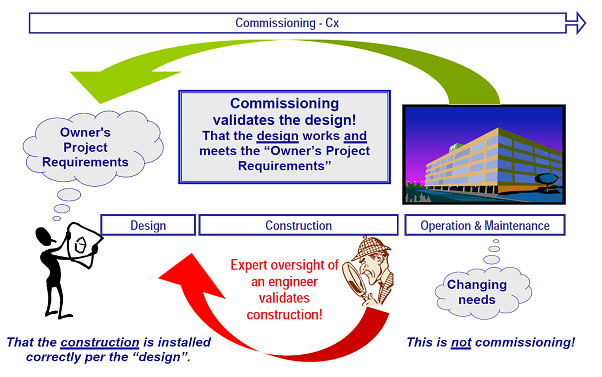Commissioning
Commissioning (Cx) is a quality-focused process of verifying and documenting that the facility and all of its systems and assemblies are planned, designed, installed, functionally tested, operated, and maintained to meet Owner’s Projects Requirements. Commissioning Authority (CxA) is an entity identified by the Owner who leads, plans, schedules, and coordinates the commissioning team to implement the Commissioning Process.
In Continental Europe mostly just expert oversight in construction phase is used, so here is short graphical presentation of difference between commissioning and expert oversight of an engineer.

The image below shows the scope of commissioning process in project timeline.

Retro-commissioning
The Commissioning Process applied to an existing facility that was not previously commissioned.
Re-Commissioning
An application of the Commissioning Process requirements to a project that has been already delivered using the Commissioning Process. This may be a scheduled re-commissioning developed as part of Ongoing Commissioning Process or it may be triggered by use change, operations problems, or other needs.
On-Going / Continuous Commissioning Process
A continuation of the Commissioning Process well into Occupancy and Operations to continually improve the operation and performance of a facility to meet current and evolving Current Facility Requirements or Owner’s Project Requirements. On-Going Commissioning Process activities occur throughout the life of the facility; some of this will be close to continuous in implementation and other will be either scheduled or unscheduled as needed.
Commissioning and LEED certification
LEED is the acronym that stands for Leadership in Energy and Environmental Design and is the Green Building Rating System developed by the U.S. Green Building Council. LEED certification provides independent, third-party verification that a building was designed and built using strategies aimed at achieving high performance in key areas of human and environmental health: sustainable site development, water savings, energy efficiency, materials selection and indoor environmental quality. Credits and Prerequisites are organized into these five categories. LEED certification can be achieved in new construction as well as renovations and can be attained on four different levels (Certified, Silver, Gold, and Platinum).
LEED certification recognizes commissioning as a great way to catch mistakes like missing or incorrectly installed equipment, avoiding occupant complaints and callbacks, indoor air quality and thermal comfort problems, premature equipment failure, and litigation. Commissioning helps fill the gap between the design team, whose members usually aren’t meant to be responsible for checking minor construction details, and subcontractors, who may inadvertently err on key items like fan power settings or sensor locations. The Commissioning Authority or Agent (CxA) is the individual designated to organize, lead, and review the completion of commissioning process activities. The CxA facilitates communication among the owner, designer, and contractor to ensure that complex systems are installed and function in accordance with the owner's project requirements. The CxA also provides the owner with the expert oversight of an engineer.
LEED divides the commissioning process into two parts. Fundamental commissioning is a LEED prerequisite and focuses on installation and verification of the mechanical and electrical systems during construction. Enhanced commissioning covers a broader scope of systems, and involves broader participation of the CxA, beginning during construction documents and continuing through occupancy. Enhanced commissioning can offer additional benefits by involving the CxA earlier during design (instead of at the bid stage), by requiring the CxA to conduct design review and to review contractor submittals, by requiring the CxA to develop an operations manual and verify that staff are trained with it, and by requiring the CxA to review operations within 8–10 months of substantial completion.
The scope of commissioning for LEED certification includes at least:
- Heating, cooling, refrigeration, ventilation systems and controls
- Lighting and day-lighting controls
- Domestic hot water systems
- Renewable energy systems
Commissioning and EPBD
In 2010, a recast of the EPBD (Energy Performance of Buildings Directive 2010/31/EU) was adopted by the European Parliament and the Council of the European Union in order to strengthen the energy performance requirements and to clarify and streamline some of the provisions from the 2002 Directive. New recast of directive defines “technical building systems” as technical equipment for the heating, cooling, ventilation, hot water, lighting, or for combination thereof, of building or building unit. Article 8 requires that Member States shall, for the purpose of the optimizing the energy use, set system requirements in respect of the overall energy performance, the proper installation, and the appropriate dimensioning, as well as adjustment and control for technical building systems in existing building. In other words, commissioning and retro-commissioning in existing building are required.

